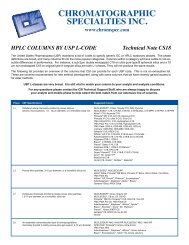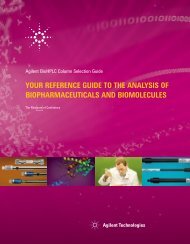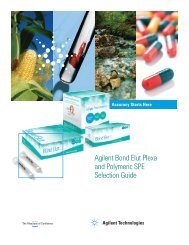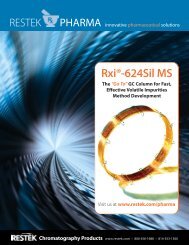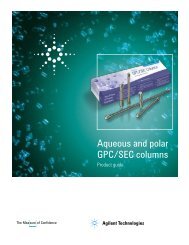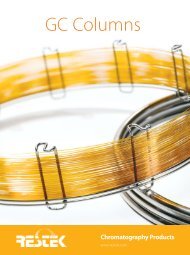Optimizing the Analysis of Volatile Organic Compounds
Optimizing the Analysis of Volatile Organic Compounds
Optimizing the Analysis of Volatile Organic Compounds
Create successful ePaper yourself
Turn your PDF publications into a flip-book with our unique Google optimized e-Paper software.
8<br />
Step 2.<br />
Purge (wet)<br />
• <strong>Volatile</strong>s in matrix diffuse into carrier<br />
gas as gas is bubbled (purged) through<br />
<strong>the</strong> matrix. <strong>Volatile</strong>s are transferred<br />
to <strong>the</strong> trap.<br />
Typical flow:<br />
30–50mL/min.<br />
for 10–15 min.<br />
Step 3.<br />
Purge (dry)<br />
Trap is dried by purging with<br />
gas only.<br />
Typical time: 1-4min.<br />
Step 4.<br />
Desorb Preheat<br />
Trap is heated without flow,<br />
to minimize analyte desorb<br />
time from packing material.<br />
Typical temp.:<br />
5°C below desorb temp.<br />
x<br />
www.restekcorp.com<br />
x<br />
Sequences and Flow Paths <strong>of</strong> <strong>the</strong> Purge and Trap Unit<br />
Purge and trap units are designed to have separate flow rates for <strong>the</strong> purge gas and <strong>the</strong> desorb<br />
(carrier) gas. The recommended gas for both purging and desorption is helium. The<br />
purge gas flow typically is set at 30-50mL/min. The desorb gas flow ranges from 10-<br />
80mL/min., depending on <strong>the</strong> column type and GC equipment used (see <strong>the</strong> Applications<br />
section <strong>of</strong> this guide for example chromatograms). The desorb gas should be controlled<br />
using a flow controller. The flow controller from <strong>the</strong> injection port <strong>of</strong> <strong>the</strong> GC commonly is<br />
used, but a separate flow controller can be connected to <strong>the</strong> desorb gas bulkhead fitting on<br />
<strong>the</strong> back <strong>of</strong> <strong>the</strong> purge and trap system. Hydrocarbon traps should be installed on <strong>the</strong> carrier<br />
gas line prior to <strong>the</strong> purge and trap system. This will prevent trace hydrocarbon or solvent<br />
“ghost peak” contamination from interfering with <strong>the</strong> analyses.<br />
Purge and trap techniques involve <strong>the</strong> following series <strong>of</strong> steps that must be followed to<br />
ensure accurate and reproducible results:<br />
Step 1. Standby<br />
During <strong>the</strong> standby mode, <strong>the</strong> purge gas flow is stopped, <strong>the</strong> trap is cooled, and <strong>the</strong> system is<br />
readied for <strong>the</strong> start <strong>of</strong> an analysis. The desorb gas bypasses <strong>the</strong> trap and is directed onto <strong>the</strong><br />
column as <strong>the</strong> carrier gas flow. The gas flow rate through <strong>the</strong> column can be measured.<br />
Step 2. Purge (wet)<br />
During <strong>the</strong> wet purge, <strong>the</strong> purge gas flow passes through <strong>the</strong> purge vessel, removes volatile<br />
analytes from <strong>the</strong> sample, and sweeps <strong>the</strong> analytes through <strong>the</strong> heated valve onto <strong>the</strong> adsorbent<br />
trap. The analytes are collected on <strong>the</strong> trap and <strong>the</strong> purge gas exits through <strong>the</strong> purge<br />
vent. The purge gas flow typically is set at 30-50mL/min. and can be measured at <strong>the</strong> purge<br />
vent. Samples usually are purged for 10-15 minutes. During <strong>the</strong> purge mode, <strong>the</strong> desorb<br />
(carrier) gas is directed onto <strong>the</strong> column.<br />
Step 3. Purge (dry)<br />
During <strong>the</strong> wet purge, a large amount <strong>of</strong> water is removed from <strong>the</strong> sample and collects on<br />
<strong>the</strong> trap. The dry purge removes <strong>the</strong> excess water that accumulated. During <strong>the</strong> dry purge,<br />
<strong>the</strong> purge gas bypasses <strong>the</strong> purge vessel and is directed to <strong>the</strong> trap. The dry purge gas<br />
removes water and carries it out <strong>the</strong> exit vent. The desorb (carrier) gas is directed onto <strong>the</strong><br />
column. Only traps that incorporate hydrophobic adsorbents can be dry purged.<br />
Step 4. Desorb Preheat<br />
Once <strong>the</strong> analytes have been trapped and excess water removed, <strong>the</strong> purge gas flow is<br />
stopped. During this static period, <strong>the</strong> trap is rapidly heated to ~5°C below <strong>the</strong> desorb temperature<br />
<strong>of</strong> <strong>the</strong> adsorbent materials used. The desorb preheat step uniformly volatilizes <strong>the</strong><br />
sample to create a narrow sample band and a more efficient sample transfer onto <strong>the</strong> GC column.<br />
Without a desorb preheat step <strong>the</strong> peaks would tail, resulting in poor chromatography.<br />
During <strong>the</strong> desorb preheat step <strong>the</strong> desorb (carrier) gas is directed onto <strong>the</strong> column.





